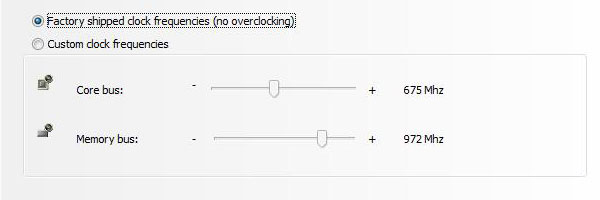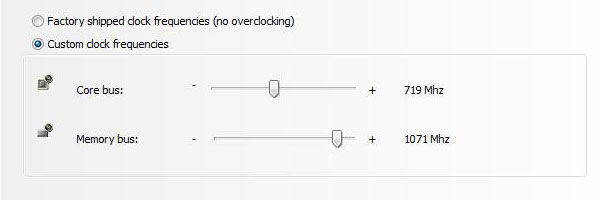Overclocking:
Since the current version of RivaTuner doesn’t work with Nvidia’s latest drivers, we chose to use Nvidia nTune for our overclocking endeavours with BFG Tech’s GeForce 8800 GTS OC 512MB card.As a quick reminder, BFG’s factory-overclocked 8800 GTS 512MB comes with default speeds of 675MHz core, 1,674MHz stream processor and 1,940MHz (effective) memory.
After a couple of hours of tweaking and stability testing using Crysis (it’s a hard life... I know), we found that we were able to increase these frequencies relatively successfully, with the core clocked at 719MHz and memory at 2142MHz (effective).


This represents increases of 101MHz (202MHz effective) on the memory and 44MHz on the core. If you factor in the fact that the BFG Tech card already has a 25MHz core speed increase by default, the overclock represents a 69MHz increase – that’s not too bad in the grand scheme of things. Sadly, we are unable to report the shader clock increase at the moment because RivaTuner version 2.06 doesn’t work correctly with the drivers used – all of the Forceware-specific options are not available.
Final Thoughts...
With the recent price drops on Nvidia’s GeForce 8800 GT, GeForce 8800 GTS 512MB and GeForce 8800 GTX, there are some interesting options on the market for gamers. At the same time we can’t forget the Radeon HD 3870 X2 either, but as we stated during our review earlier this week, we’re hesitant to give it a solid recommendation because its reliance on drivers.The cheapest GeForce 8800 GTS 512MB we’ve found is priced at £194.17, including VAT and it’s clocked at Nvidia’s reference speeds. BFG Tech’s card, on the other hand, costs about £10 more at £205.50 (inc. VAT) and comes with a fairly modest factory overclock, but it’s an overclock nevertheless. The result is a relatively unnoticeable performance increase, but what it should mean is that there is the potential for a higher overclock as the chips are qualified to run at higher-than-standard speeds.
Update: it's also available on OcUK for £204.44 (inc. VAT), but remember that you'll get free delivery from Scan if you're a regular contributor in the bit-tech forums.
In addition to that, BFG sweetens the deal with its 10-year warranty in Europe (and a Lifetime warranty in North America) – and there are few graphics board partners that match BFG on this front.
We couldn’t talk about the GeForce 8800 GTS 512MB without mentioning the alternatives—such as the GeForce 8800 GT and GeForce 8800 GTX—that are tentatively priced either side of the card we’re looking at here today. Ultimately, the choice on whether you need to spend £150, £200 or £250 will depend on your requirements.
1680x1050 seems to be the optimal resolution for the GeForce 8800 GTS 512MB, but performance doesn’t tail off too much at 1920x1200; therefore, if you’re gaming on a higher-resolution screen, we’d recommend plumping for a GeForce 8800 GTX or Radeon HD 3870 X2. However, if you’ve got a 1280x1024 screen you should probably save the cash and opt for a GeForce 8800 GT. It’s also worth mentioning that the GeForce 8800 GT is a pretty capable card at 1680x1050 as well – although it’s not as competent as the 8800 GTS 512MB, where it’s around 15 percent slower on average.
You’re probably wondering why I’ve not mentioned the alternatives from ATI yet – that’s because there really isn’t any alternative at this price point. The newly-released Radeon HD 3870 X2 typically retails for around £270 (inc. VAT)—some £65 more than the BFG Tech GeForce 8800 GTS 512MB. And at the other end of the scale, the Radeon HD 3870 is available for around £130 (inc. VAT) – that’s about £65 less than the cheapest 8800 GTS 512MB and it’s in a different performance class.
So, BFG Tech’s GeForce 8800 GTS OC 512MB appears to have hit a price point that can’t be matched by anything other than stock-clocked GeForce 8800 GTS 512MB cards and as such it earns a recommendation from us. However, it’s important to make sure that it’s going to be connected to a 1680x1050 or 1920x1200 display, as that will show the card in its best possible light. You can get away with running the BFG Tech GeForce 8800 GTS 512MB on higher or lower resolution screens, but the benefits of the card aren’t going to be quite so profound.
- Features
- x
- x
- x
- x
- x
- x
- x
- x
- -
- -
- 8/10
- Performance
- x
- x
- x
- x
- x
- x
- x
- x
- x
- -
- 9/10
- Value
- x
- x
- x
- x
- x
- x
- x
- x
- x
- -
- 9/10
- Overall
- x
- x
- x
- x
- x
- x
- x
- x
- x
- -
- 9/10

BFG Tech GeForce 8800 GTS OC 512MB

MSI MPG Velox 100R Chassis Review
October 14 2021 | 15:04









Want to comment? Please log in.